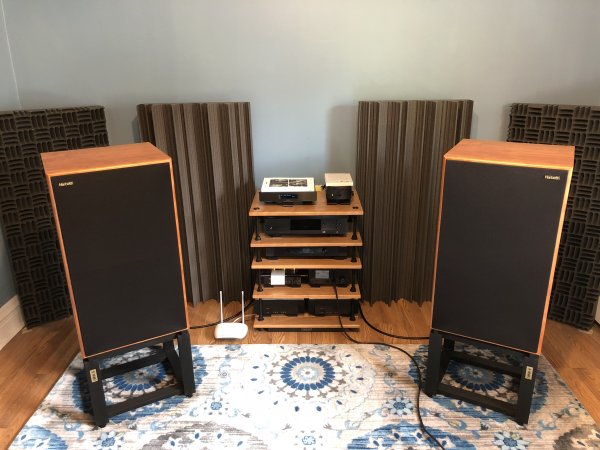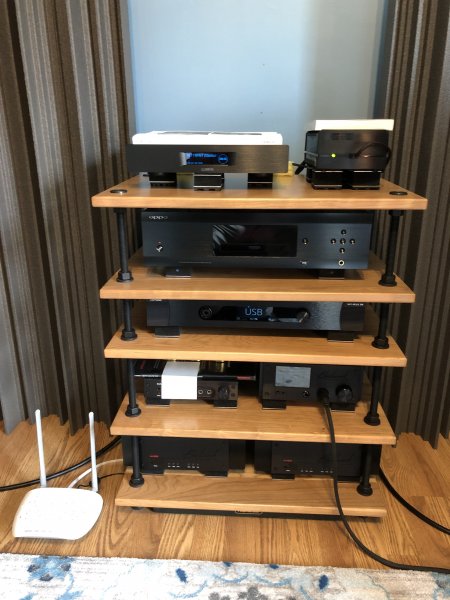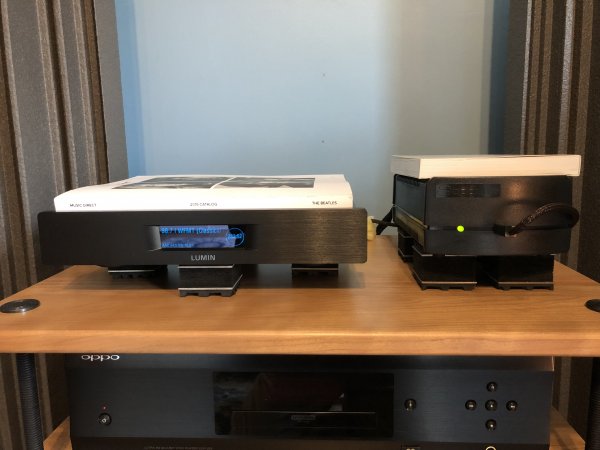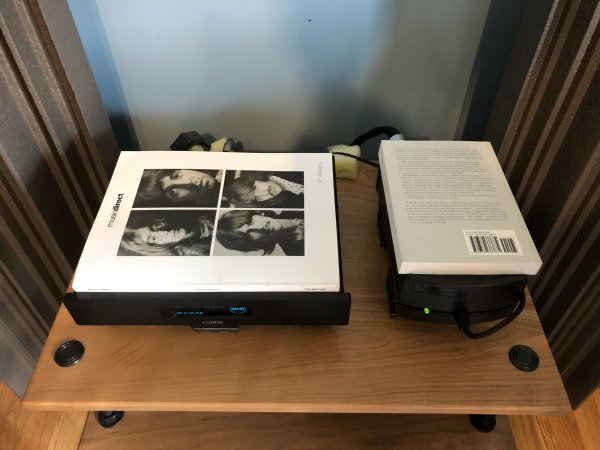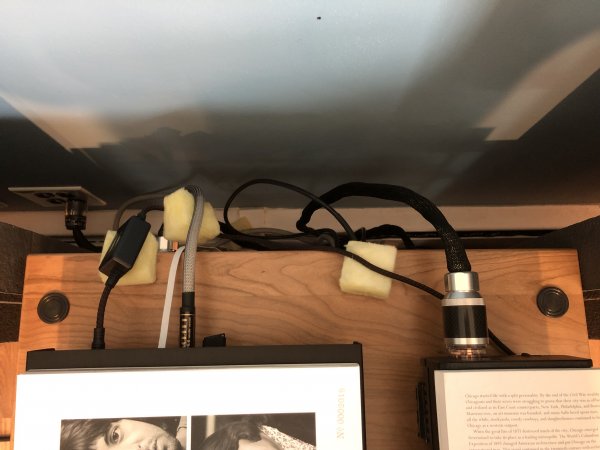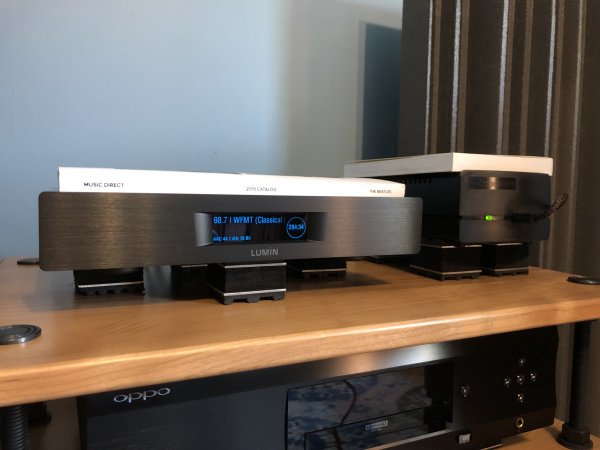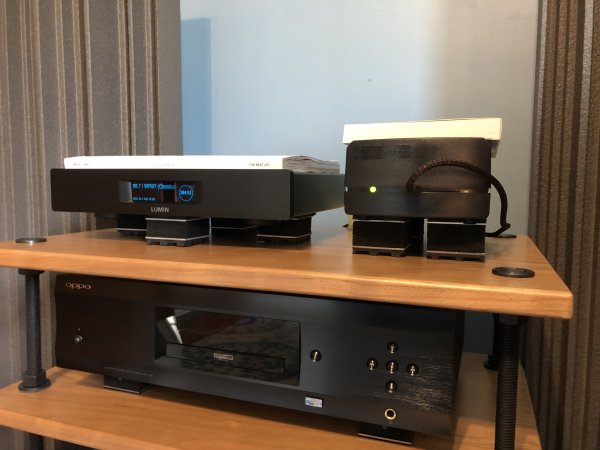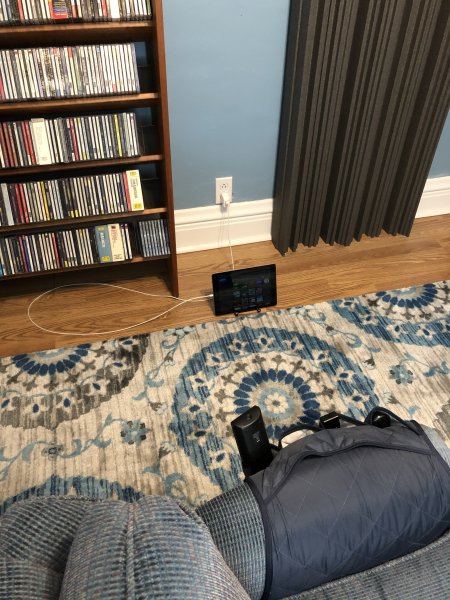Lumin on My Radar
The Lumin products started appearing on my personal audio radar following the problems I encountered with my Auralic Aries G2 (as described in this post in the Auralic's thread).
Now, most high-end streamers are not known for ease of use or reliable functioning. Those who use general purpose computers for audio streaming have no idea how good they have it in terms of reliable, non-flaky functionality. I have found that out myself with my new headphone listening system built around my Dell all-in-one desktop computer, discussed here. I'm sure the sonics of the streamer of such a system can be bettered, but in terms of rock-solid reliability, using a "real computer" to tune to and stream directly from music streaming websites—much less connecting to local music files—holds no surprises or glitches to annoy you.
I did note, however, how much praise the Lumin units and the Lumin control app garnered both for sonics and for reliable, non-glitchy operation, as well as the supposedly top-notch GUI. Lumin also seems to be one of the most responsive companies to fixing any glitches users discover, releasing periodic fixes as well as software/firmware enhancements. These are automatically installed as released.
As before with my choice of the Auralic Aries G2, I wanted to concentrate on a unit without a built-in DAC for two reasons. First, I think my Benchmark DAC3 HGC is very natural sounding and don't want to give that up.
Second, I want to be able to use an equalizer in the digital domain to do room correction for my Harbeth M40.2 speakers. Unless the streamer incorporates digital parametric equalization (as the Aries G2 now does), that means I couldn't really use a separate digital equalizer and still use the DAC built into a streamer. While every Lumin streamer has a digital output (even though they also have onboard DACs), as far as I know, no streamer allows output of a digital signal into a digital EQ, with the output of the digital EQ then being allowed back into that streamer's DAC. There are no "pre out/power in" jacks in digital equipment as there were in some old analog integrated amps and receivers. Such two-way traffic might work via a USB hub, but, without testing it, I'm not sure.
This meant either the Lumin U1 at $6,000 or the U1 mini at $2,000. I chose the stripped-down U1 mini because of (1) the huge cost difference despite similar functionality and active parts (2) knowing that the sonics of the U1 Mini could be further improved by addition of an external linear power supply to replace the Mini's internal switch mode power supply, thus mimicking the U1 arrangement, (3) not needing the highest DSD and PCM speeds offered by the U1, and (4) figuring that the power line and anti-vibration treatments I would be using with the Mini might further close any performance gap related to the difference in chassis construction between the solid-aluminum block U1 and the assembled aluminum pieces of the U1 Mini.
Besides, if down the road I decide I really want the top Lumin streamer, I probably would not go with the U1. I'd just skip the U1 and go up to the X1 and not use the DAC in that unit. The X1's DAC would still be available if a means of applying digital EQ with that unit is feasible, such as via Roon or via firmware changes to the Lumin which might eventually add digital EQ functions to the firmware, as was the case with the Auralic Aries G2.
Enter the Lumin U1 Mini + Sbooster Power Supply
Upscale Audio in California is not only a Lumin U1 Mini dealer, but also the USA distributor for the European Sbooster external linear power supply and Lumin Connection Kit for the Sbooster which I intended to use with the U1 mini to replace its internal switch-mode power supply. I decided to order the Lumin from Upscale Audio in California, plus the Sbooster power supply and Lumin installation kit. Upscale had a black open box unit which I got for $1,800. It was pristine, as far as I could tell, both the unit and the packaging.
Sbooster Installation
I immediately installed the Sbooster kit because I wanted to make sure that was doable at my skill level. Thus, I really can't compare the sound with and without the Sbooster.
I encountered no real problems with installing the Sbooster kit; the installation directions for the kit are accurate and clear enough. I would recommend that you have a regular Torx T-10 screwdriver handy, though. The mini-handled version which comes with the kit fits the Torx screws on the U1 Mini chassis fine, but is only marginal in its ability to safely apply enough torque to remove some of those screws. The larger diameter handle of a regular T-10 driver makes the job so much easier.
However, contrary to one online description of the kit, most buyers of the Sbooster and Lumin Connection Kit will have to cut one wire. The installation directions which come with the kit call for that one wire to be cut. It's a short red wire near the back of the chassis which runs between the power switch to the IEC power inlet. The connections of that wire to the switch and inlet are soldered and then the soldered connections were covered with heat-shrink tubing. The wire is cut to allow the IEC power inlet to be removed from the chassis by pulling it out from outside the back panel of the chassis. I'm sure a competent electronics technician could remove the heat-shrink tubing and then unsolder the connection at the IEC inlet to allow the IEC inlet to be removed from the chassis and allow installation of the Lumin connection kit in the hole left by the removed IEC inlet, but performing that operation is not comfortably within my skill set. Not cutting this wire could theoretically allow the Lumin Mini internal power supply to be re-installed without obvious rewiring.
Thus, since most installers of the Lumin Connection kit will have to cut that wire, I consider this modification irreversible for most owners once it's done. I also would not count on Lumin honoring the warranty on a unit which obviously has had its internal wiring tampered with. Your retail dealer for the Lumin and/or the Sbooster would be your best recourse for warranty repair.
Once the Sbooster Connection Kit is installed, the power switch on the back of the Lumin U1 Mini is non-functional. You now turn the U1 Mini on and off with the power switch on the back of the Sbooster unit. Note that Lumin recommends that the U1 Mini remain constantly powered up anyway, so you shouldn't need to operate that Sbooster power switch very often.
[continued below]
The Lumin products started appearing on my personal audio radar following the problems I encountered with my Auralic Aries G2 (as described in this post in the Auralic's thread).
Now, most high-end streamers are not known for ease of use or reliable functioning. Those who use general purpose computers for audio streaming have no idea how good they have it in terms of reliable, non-flaky functionality. I have found that out myself with my new headphone listening system built around my Dell all-in-one desktop computer, discussed here. I'm sure the sonics of the streamer of such a system can be bettered, but in terms of rock-solid reliability, using a "real computer" to tune to and stream directly from music streaming websites—much less connecting to local music files—holds no surprises or glitches to annoy you.
I did note, however, how much praise the Lumin units and the Lumin control app garnered both for sonics and for reliable, non-glitchy operation, as well as the supposedly top-notch GUI. Lumin also seems to be one of the most responsive companies to fixing any glitches users discover, releasing periodic fixes as well as software/firmware enhancements. These are automatically installed as released.
As before with my choice of the Auralic Aries G2, I wanted to concentrate on a unit without a built-in DAC for two reasons. First, I think my Benchmark DAC3 HGC is very natural sounding and don't want to give that up.
Second, I want to be able to use an equalizer in the digital domain to do room correction for my Harbeth M40.2 speakers. Unless the streamer incorporates digital parametric equalization (as the Aries G2 now does), that means I couldn't really use a separate digital equalizer and still use the DAC built into a streamer. While every Lumin streamer has a digital output (even though they also have onboard DACs), as far as I know, no streamer allows output of a digital signal into a digital EQ, with the output of the digital EQ then being allowed back into that streamer's DAC. There are no "pre out/power in" jacks in digital equipment as there were in some old analog integrated amps and receivers. Such two-way traffic might work via a USB hub, but, without testing it, I'm not sure.
This meant either the Lumin U1 at $6,000 or the U1 mini at $2,000. I chose the stripped-down U1 mini because of (1) the huge cost difference despite similar functionality and active parts (2) knowing that the sonics of the U1 Mini could be further improved by addition of an external linear power supply to replace the Mini's internal switch mode power supply, thus mimicking the U1 arrangement, (3) not needing the highest DSD and PCM speeds offered by the U1, and (4) figuring that the power line and anti-vibration treatments I would be using with the Mini might further close any performance gap related to the difference in chassis construction between the solid-aluminum block U1 and the assembled aluminum pieces of the U1 Mini.
Besides, if down the road I decide I really want the top Lumin streamer, I probably would not go with the U1. I'd just skip the U1 and go up to the X1 and not use the DAC in that unit. The X1's DAC would still be available if a means of applying digital EQ with that unit is feasible, such as via Roon or via firmware changes to the Lumin which might eventually add digital EQ functions to the firmware, as was the case with the Auralic Aries G2.
Enter the Lumin U1 Mini + Sbooster Power Supply
Upscale Audio in California is not only a Lumin U1 Mini dealer, but also the USA distributor for the European Sbooster external linear power supply and Lumin Connection Kit for the Sbooster which I intended to use with the U1 mini to replace its internal switch-mode power supply. I decided to order the Lumin from Upscale Audio in California, plus the Sbooster power supply and Lumin installation kit. Upscale had a black open box unit which I got for $1,800. It was pristine, as far as I could tell, both the unit and the packaging.
Sbooster Installation
I immediately installed the Sbooster kit because I wanted to make sure that was doable at my skill level. Thus, I really can't compare the sound with and without the Sbooster.
I encountered no real problems with installing the Sbooster kit; the installation directions for the kit are accurate and clear enough. I would recommend that you have a regular Torx T-10 screwdriver handy, though. The mini-handled version which comes with the kit fits the Torx screws on the U1 Mini chassis fine, but is only marginal in its ability to safely apply enough torque to remove some of those screws. The larger diameter handle of a regular T-10 driver makes the job so much easier.
However, contrary to one online description of the kit, most buyers of the Sbooster and Lumin Connection Kit will have to cut one wire. The installation directions which come with the kit call for that one wire to be cut. It's a short red wire near the back of the chassis which runs between the power switch to the IEC power inlet. The connections of that wire to the switch and inlet are soldered and then the soldered connections were covered with heat-shrink tubing. The wire is cut to allow the IEC power inlet to be removed from the chassis by pulling it out from outside the back panel of the chassis. I'm sure a competent electronics technician could remove the heat-shrink tubing and then unsolder the connection at the IEC inlet to allow the IEC inlet to be removed from the chassis and allow installation of the Lumin connection kit in the hole left by the removed IEC inlet, but performing that operation is not comfortably within my skill set. Not cutting this wire could theoretically allow the Lumin Mini internal power supply to be re-installed without obvious rewiring.
Thus, since most installers of the Lumin Connection kit will have to cut that wire, I consider this modification irreversible for most owners once it's done. I also would not count on Lumin honoring the warranty on a unit which obviously has had its internal wiring tampered with. Your retail dealer for the Lumin and/or the Sbooster would be your best recourse for warranty repair.
Once the Sbooster Connection Kit is installed, the power switch on the back of the Lumin U1 Mini is non-functional. You now turn the U1 Mini on and off with the power switch on the back of the Sbooster unit. Note that Lumin recommends that the U1 Mini remain constantly powered up anyway, so you shouldn't need to operate that Sbooster power switch very often.
[continued below]
Last edited:


